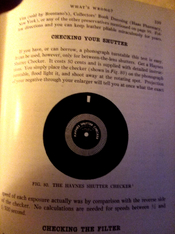I got out my old book from the jr high, from when the teachers were lecturing and I was "following along in my textbook". Of course my photography books were inside my textbook, so they wouldn't know. Here it is. the Haynes Shutter checker. Never saw one, but I bet it's dead-perfect, if you don't mind burning through some film to use it.
-
Welcome to Photrio!Registration is fast and free. Join today to unlock search, see fewer ads, and access all forum features.Click here to sign up
Testing leaf shutter consistency across speeds
-
A
- Thread starter miha
- Start date
| Photrio.com contains affiliate links to products. We may receive a commission for purchases made through these links. To read our full affiliate disclosure statement please click Here. |
PHOTRIO PARTNERS EQUALLY FUNDING OUR COMMUNITY:  |


